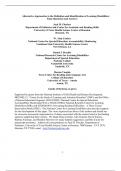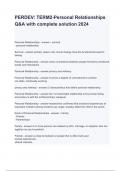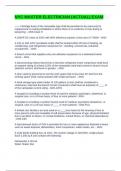Alternative Approaches to the Definition and Identification of Learning Disabilities:
Some Questions and Answers
Jack M. Fletcher
Department of Pediatrics and Center for Academic and Reading Skills
University of Texas Health Science Center at Houston
Houston, TX
W. Alan Coulter
National Center for Special Education Accountability Monitoring
Louisiana State University Health Science Center
New Orleans, LA
Daniel J. Reschly
National Research Center for Learning Disabilities
Department of Special Education
Peabody College
Vanderbilt University
Nashville, TN
Sharon Vaughn
Texas Center for Reading and Language Arts
College of Education
University of Texas – Austin
Austin, TX
Annals of Dyslexia, in press
Supported by grants from the National Institute of Child Health and Human Development,
HD25802-13, “Center for the Study of Learning and Attention Disorders” (JMF); and the Office
of Special Education Programs: H326Y02002, National Center for Special Education
Accountability Monitoring (WAC); H324U010004, National Research Center for Learning
Disabilities (DJR), and H324X010013, Preventing Reading Difficulties: A Three-Tiered
Intervention Model (SRC). The National Center for Learning Disabilities also provided support
for the development of this paper. The views expressed are those of the authors and should not
be viewed as necessarily representative of others associated with the centers listed or the funding
agencies supporting these centers. We thank Doug Carnine, Alex Grazine, David Francis,
Barbara Foorman, and Sheldon Horowitz for many helpful suggestions, and Rita Taylor for
manuscript assistance. Address all correspondence to Jack M. Fletcher, Department of
Pediatrics, University of Texas Health Science Center at Houston, 7000 Fannin – UCT 2478,
Houston, TX 77030; email: Jack.Fletcher@uth.tmc.edu
1
, Abstract
Recent consensus reports concur in suggesting major changes in the Federal regulatory
approach to the identification of learning disabilities (LD). These reports recommend
abandoning the IQ-discrepancy model and the use of IQ tests for identification, and also
recommend incorporation of responsiveness to intervention (RTI) as one of the identification
criteria. These changes are also recommended to states in the current reauthorization of the
United States’ Individuals with Disabilities in Education Act (IDEA). While not mandatory,
states that follow these recommendations will experience major changes in identification and
treatment of students served under the LD category. This paper reviews the basis for these
recommendations, summarizing four recent consensus group reports on special education that
concur in suggesting these changes. Seventeen commonly asked questions about these changes
are presented, with responses. In order to ensure adequate instruction for students with LD, it is
essential that identification practices focus on assessments that are directly related to instruction,
that any services for students who are struggling prioritize intervention over eligibility, and that
special education be permitted to focus more on results and outcomes, and less on eligibility and
process. Identification models that incorporate RTI represent a shift in special education towards
the goals of better achievement and behavioral outcomes for students identified with LD as well
as those students at risk for LD.
2
, Alternative Approaches to the Definition and Identification of Learning Disabilities:
Some Questions and Answers
In the past few years, increasing concern has been expressed in the United States about
common definitions and procedures for identifying students with learning disabilities (LD).
These concerns involve all four components of most definitions of LD, including the Federal
definition recommended in 1977 to States by the United States Office of Education (USOE,
1977). Three of these components - discrepancy, heterogeneity, and exclusion – can be found in
the 1977 Federal definition. Discrepancy in most definitions is indicated by the presence of a
difference between aptitude and achievement, represented in the Federal regulatory definition as
a severe discrepancy between IQ and achievement test scores. Heterogeneity represents the
multiple domains in which LD occurs: seven in the 1977 Federal definition, including various
disorders of reading, math, written expression, and language. The exclusion component reflects
the orientation that LD should not be identified if the primary cause involves a sensory disorder,
mental deficiency, emotional disturbance, economic disadvantage, linguistic diversity, or
inadequate instruction. In addition, these three components- discrepancy, heterogeneity, and
exclusion - are the basis for the fourth component of most definitions, the belief that LD is due to
constitutional factors intrinsic to the student. Thus, a student who meets the criteria stemming
from the first three components is presumed to have an achievement problem that is due to
neurobiological factors. These components, which have served as the foundation for identifying
students with LD since the inception of the construct, resulted from a general agreement that this
was the best way to proceed considering the lack of empirical evidence. These components of
3
, most definitions continue to prevail despite the emergence of a significant evidence base that
suggests problems and alternatives to this consensus.
In the United States, recent efforts at educational reform have focused on the notion of
accountability for results and the implementation of evidence-based instructional approaches.
These efforts have specifically targeted improving reading instruction, reflecting the
accumulation of research on how children learn to read and how to assist struggling readers. The
impetus for reform and the emphasis on reading have multiple sources, the most salient being
stagnant gains on different national and international assessments over the past 20 years. Of
significant concern was the failure of schools to close the gap between achievement scores of
economically advantaged, primarily non-minority students, and economically disadvantaged,
predominantly minority students. These concerns eventuated in the reauthorization of the
Elementary and Secondary Education Act, or the No Child Left Behind Act of 2001, Public Law
107- 110 (NCLB, 2002). Fundamental to NCLB is Reading First, which requires the
implementation of approaches to reading instruction supported by scientifically based reading
research documented in multiple consensus reports such as the 1998 National Research
Council’s Preventing Reading Difficulties in Young Children (Snow, Burns, and Griffin, 1998),
the report of the National Research Panel (2000), and a report on reading comprehension by the
RAND Reading Study Group (2002).
These same issues are affecting the major piece of special education legislation in the
United States, the Individuals with Disabilities in Education Act (IDEA), which is presently
being considered for reauthorization by Congress. This reauthorization was preceded by four
consensus reports on special education: the National Research Council report on minority
overrepresentation in special education (Donovan & Cross, 2002), a report entitled Rethinking
4






